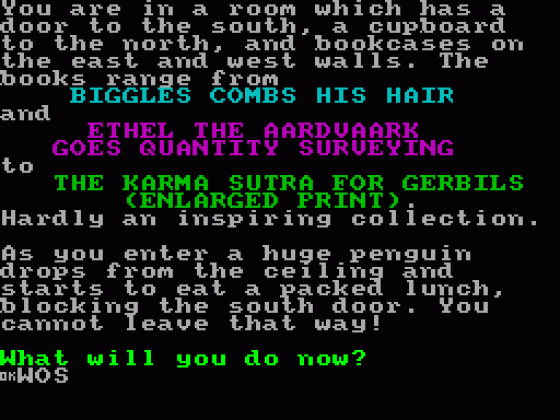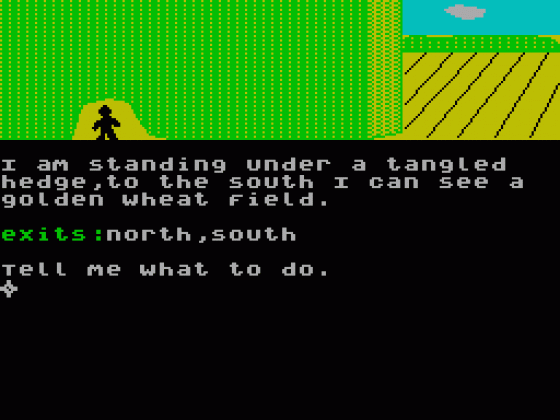
Crash
 1st April 1986
1st April 1986
Categories: Review: Software
Author: Derek Brewster
Publisher: Global
Machine: Spectrum 48K/128K
Published in Crash #27
Fourmost Adventures
Well, we've had hit compilations in pop music and, more recently, compilations of computer classics. Here we have four adventure games, which, if not classics, are above average and well worth a look. The tape carries four adventures chosen by Tony Bridge who writes a weekly column in Popular Computing Weekly.
Heading the cast is Mizar's Out of the Shadows which was Smashed here in December 84 only to flounder for reasons only too familiar to small computer companies the shops would take anything from large established firms, obvious winners from small concerns, but nothing involved or adventurous from new quarters. The fact that the high street shops ended up with a big load of old rubbish on their shelves in any case is neither here nor there, small games houses didn't stand a chance. Out of the Shadows still plays like a very good program but the graphics are crude by todays exacting standards, and indeed, if any criticism can be aimed at a tape that brings you four full games for under E8, it is that the games on this tape are a little dated. That said, the tape represents exceedingly good valve for money.
Out of the Shadows is an arcade adventure which dwells in the world of monsters and magic requiring a subtle blend of technique with out and out battle bravado. It stands as one of the more successful attempts to bring the flavour of the Dungeons and Dragons game to the computer screen. The figures behind the game are impressive. 300 commands, 500 locations, 14 types of monster and 50 different types of object describe what is a deceptively complex game (for some tips on play see CRASH May 851.
The principal innovation which runs through the game, and the one which gives the game its title, is the way the ground about you is illuminated by your flame when play takes you below ground or after nightfall. What tends to come out of the shadows is a whole horror film of assorted nasties which become more obstructive the deeper you go down the dungeon. To light the shadows your player, whether elf, human or dwarf, uses a lantern and torches. As you move around, the shadows sweep across the floor in a very realistic fashion. When in the dungeon you must keep an eye on the level of oil in your lantern and check how many torches you have left. A lantern casts a larger light than a torch and when a torch goes down the lighted area it reveals slowly diminishes and the darkness closes in around you.
There are six quests and if this were not enough there are many variations on each theme. The same quest can be tackled by different players in competition where how long each game takes and how many times it has been saved are the deciding factors. A hero of one encounter can set off on a new quest with the same hard won trophies. Possessions such as torches and copper coins are soon amassed by opening or attacking crates and jars. Valuables can be taken to the shop for the buying and selling of provisions such as food, needed to counteract the energy-sapping spells you cast. Delving deeper into the dungeon you meet more powerful adversaries and the burden of ever increasing treasures, which weigh you down and make you short of breath during combat. Taking on foes leads to increased confidence, strength and dexterity. Should combat become too injurous, it's worth remembering how natural healing occurs at a greater pace nearer the surface.
Project X The Microman was reviewed here in September 85 and was the game that used every programming aid in the book: Melbourne Draw for its loading screen, Quill & illustrator, and The Patch, a programming device which explains the sudden appearance of startlingly realistic telephone ringings, wailing sirens and so on. The game sports the extremely useful STORE/RECALL from memory commands while the standard of screen presentation is very high with a smart and helpful text layout and different colours breaking up the screen.
The story centres around a Professor Neil Richards whom you play as he struggles to come to terms with a freak accident in his laboratory. While working there he irradiates himself and immediately drives off to his colleague's lab a few miles away. Your task is to enter the colleague's home but your size has been reduced to that of a hamster and your friend's house is protected by COM 2, a high-tech security computer. The computer's chief task is to stop intruders entering the lab, something you must do to attain the antidote to the animal miniaturization you have inadvertently turned upon yourself.
The Mural is the second program on side one of the tape which is noteworthy for its curious introduction. The story goes like this. It's a sunny day and you're walking along Neasden High Street in the hope of finding some excitement when suddenly you're accosted by two men wearing suspender belts (anything is possible in Knees-up Neasden). You discover you have been sent by the Tight-mouse Board of Censors to engage you in a task of painting over an obscene mural. Having made their deliverance they knock you out, and here's where we actually get to the adventure you must tackle you awake to find yourself in a cave.
The first frame has moss and lichen growing in a large dark, dank cave but moss and lichen need light so that ruins this one a bit. Getting into the adventure things don't improve much. The whole of this adventure has a dated feel. Its linear storyline unfolds in a lacklustre fashion with the poor and inadequate EXAMINE command responding when the program deems it necessary. The program only responds when you're getting somewhere and so the one-way feel of the plot becomes only too apparent. In general the program is unresponsive and has a bad case of the 'You Can'ts'. Not far north of the first location you'll meet a penguin who jumps in to block your return south. There is nothing wrong with not being able to hit or kill the flipping animal, but the program could at least acknowledge your attempts to do something that's pretty obvious given the circumstances. There are many examples of dated vocabulary sorting with GET MAGGOTS failing to pick up a TIN of maggots and GET PASS failing to acquire a pass CARD. This kind of nit-picking awkwardness in adventuring passed long ago now authors are much more considerate. In other areas the program goes beyond being unresponsive and strikes a note of being purely naff. When trying to enter the back door of the cottage to the south OPEN DOOR is unsuccessful while UNLOCK DOOR does the trick; this is without picking up or using a key!
The Mural is the type of adventure which just sits there waiting for the player to input the one and only correct solution. While it waits, it sees no reason why it should keep you entertained. The lack of interaction has you quietly going off to sleep. The location descriptions are rather good but not extensively researched and the overall impression is not a good one.
Galaxias, the fourth game on the cassette, is from the same devious mind which devised Bored of the Rings and Robin of Sherlock, namely Fergus McNeill. This game predates its two famous successors but is an early sign of the inventive genius which was to give The Quill some rare chart success. Loading up, the game presents a pleasant face with a very attractive futuristic redesigned character set. What's more, it is eminently readable. Exits are clearly marked and there are a few, rather average, graphics.
As a space pirate your mission is to tour the planet of the local system and find a fabled crystal. The on board computer gives a rundown of the planets within range and much of your time is spent exploring these planets, collecting the items there, and deciphering the clues scattered about them. You begin in the hideously decorated Zagro spaceport, I mean, can you imagine a mirror glass corridor with a green roof light. The first part of the adventure unwinds itself in a reasonable manner except for the discrepancy by which food is eaten from the inventory while drink is drunk but remains in your list of possessions. An alcohol reclamation unit off the bar turns out to be the toilet with soft music to help you relax. The wall behind the bar is burnt with many laser scorch marks. There are quite a few other examples of the budding comic genius.
Galaxias is an interesting program with a superb redefined character set and some welcome comic touches. The detailed descriptions of the different planets you visit make the game most enjoyable and a notable member of the four.
Comments
Difficulty: easy to play but will take months to complete
Graphics: good original lighting concept
Presentation: very good
Input facility: arcade response
Response: good
Other Spectrum 48K Game Reviews By Derek Brewster
Scores
Spectrum 48K/128K Version| Out Of The Shadows | 9 |
| Project-X Micro Man | 6 |
| Case Of The Obscene Mural | 6 |
| Galaxias | 7 |
| Overall | 9 |














